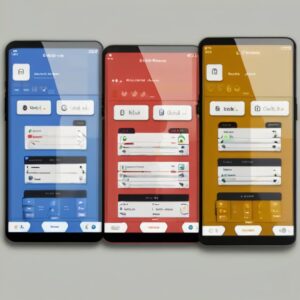Crafting a user interface (UI) that is functional and aesthetically pleasing is an artist’s craft and an engineer’s puzzle. When we talk about bespoke development, the stakes are even higher. Tailoring every element to meet specific requirements and desires without compromising usability demands an in-depth understanding of design principles, user behavior, and technical proficiency.
What is UI Customization?

UI customization is a process that involves the modification and personalization of user interface components to meet specific needs and preferences. These can be functional, such as improving the usability and efficiency of a system, or aesthetic, like enhancing the visual appeal of the interface. customization encompasses a wide range of activities, from simple changes like adjusting color schemes and fonts to more complex tasks such as developing entirely new widgets or interactive elements.
UI customization aims to create an interface that resonates with its users, making it more intuitive, engaging, and enjoyable to interact with. By tailoring the user interface to better align with user expectations and preferences, developers and designers can significantly enhance user satisfaction and productivity. This process often involves gathering feedback from end-users, conducting usability tests, and continuously iterating on the design to ensure it meets the evolving needs of its audience.
UI customization is not limited to visual changes alone. It can also include functional enhancements, such as adding new features, improving navigation, or integrating third-party services to streamline workflows. The end goal is to create a seamless and cohesive user experience that looks good and performs efficiently and effectively.
UI customization is an important aspect of user experience design, as it bridges the gap between standard, out-of-the-box solutions and the unique requirements of individual users or organizations. By investing time and resources into customizing the user interface, developers can create more personalized and user-friendly applications that stand out in an increasingly competitive digital landscape.
Why Customize?
You might wonder, why go through the trouble of customizing the UI when templates and pre-designed elements are readily available? Here are a few reasons:
- Brand Identity: a customized UI reflects the brand’s identity and its values. It makes the product recognizable and memorable.
- Improved User Experience: tailored interfaces can lead to a more intuitive and satisfying user experience.
- Functionality: off-the-shelf solutions might not cover specific functionalities needed for your application.
- Differentiation: in a saturated market, a unique and appealing UI can set your product apart from the competition.
Principles of Good UI Design
Before delving into customization techniques, it’s essential to understand the fundamental that underpin effective UI design. These principles will serve as a compass to guide your customization strategies, ensuring that the changes you implement enhance the overall interface rather than detract from it. By adhering to these principles, you can create a user experience that is intuitive, efficient, and enjoyable for a broad range of users.
One of the key principles is Visual Consistency, which involves maintaining uniformity in fonts, colors, and the placement of elements throughout the application. By keeping these visual aspects consistent, users can navigate through the application effortlessly, without being disoriented by abrupt differences in design. Consistency in visuals fosters a sense of familiarity and reinforces the brand identity, making the interface more cohesive and professional.
Equally important is Functional Consistency, which ensures that similar actions result in similar responses across the application. This predictability is important as it helps to reduce the learning curve for users. When users can rely on a consistent set of responses, they are more likely to feel confident and competent while using the application. For instance, if two buttons perform similar functions, they should provide similar feedback and outcomes.
Another principle is Feedback. When users interact with your interface, they need immediate feedback to understand the result of their actions. Feedback can manifest in various forms, such as visual cues (e.g., a button changing color when clicked), auditory signals (e.g., a sound confirming an action), or haptic responses (e.g., device vibrations). This feedback ensures that users are aware of the success or failure of their actions, promoting a smoother and more intuitive interaction.
Affordance is a design principle that focuses on making elements in your interface intuitively suggest their functionality. For example, buttons should visually indicate that they are “clickable,” and text boxes should appear “editable.” Clear affordances make the interface more user-friendly, as users can easily understand how to interact with various components without needing extensive instructions.
Accessibility is an important aspect of good UI design. A well-designed interface should be inclusive, meaning it is accessible to users with a wide range of abilities and disabilities. This involves designing with considerations such as screen readers, keyboard navigation, color contrast, and alternative text for images, ensuring that the interface is usable for everyone. By prioritizing accessibility, you create an equitable user experience that accommodates all users, including those with visual, auditory, cognitive, or motor impairments.
By incorporating these principles of visual consistency, functional consistency, feedback, affordance, and accessibility into your UI design, you lay a strong foundation for effective customization. These principles enhance the user experience and ensure that your customized interface remains user-friendly, intuitive, and inclusive.
Tools and Technologies for UI Customization
The tools and technologies you choose play a significant role in how effectively you can customize your UI. Let’s look at some popular options:
Design Tools
Sketch
A vector graphics editor, ideal for designing and prototyping user interfaces. It’s known for its simplicity and the ability to export assets easily.
Figma
A web-based interface design tool with powerful collaboration features. Multiple designers can work on the same project simultaneously.
Adobe XD
An all-in-one UX/UI solution for designing websites, mobile apps, voice interfaces, and more. Adobe XD excels in prototyping and animation.